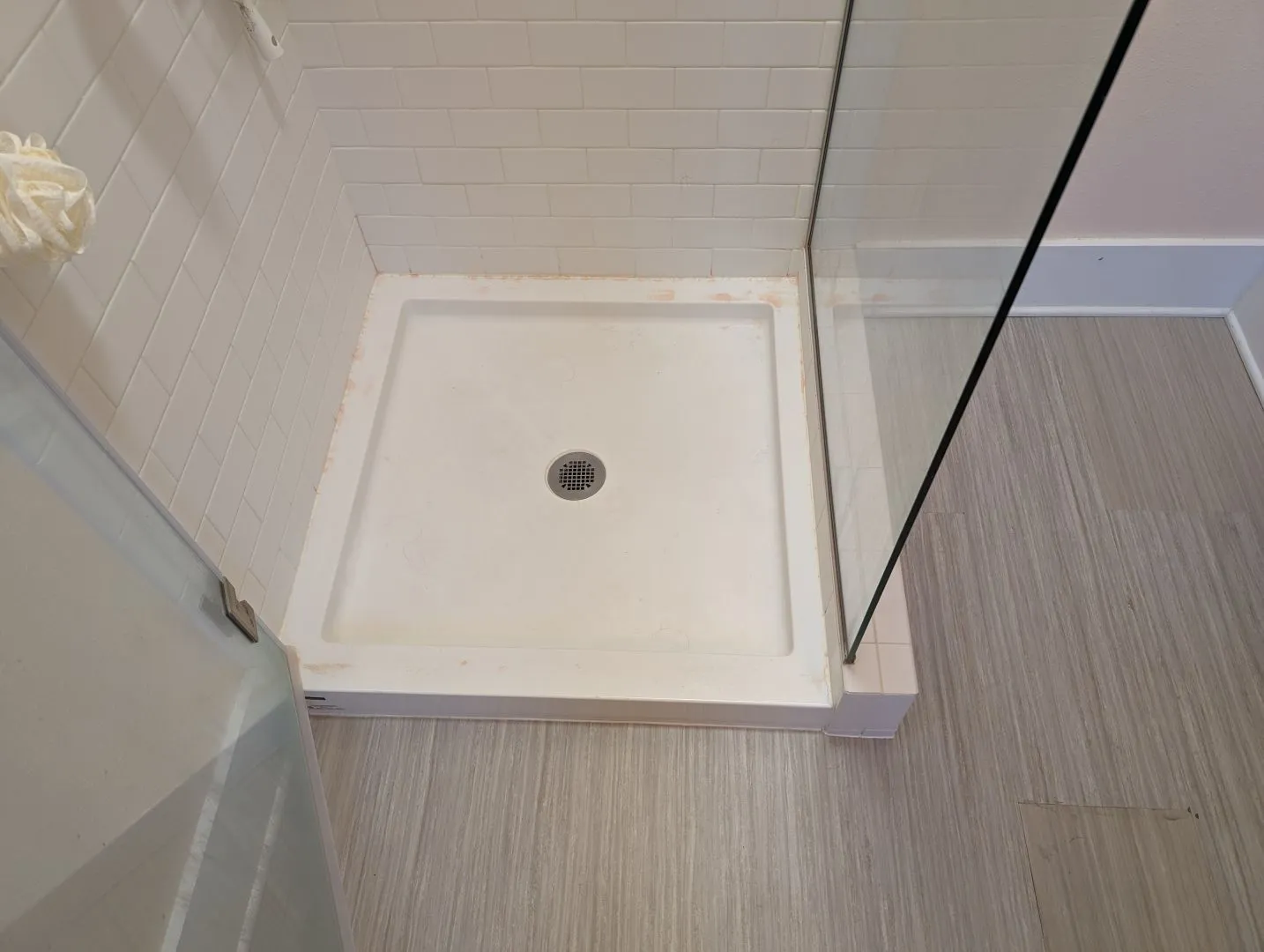We have a standing shower with a strange leak. It was built with a small tiled wall/step that the frame-less glass shower wall panel sits on. I noticed water pooling outside the door after a shower. At first I thought it was the door seal but upon closer inspection it is coming out of the grout. See pics (right where the arrow is pointing). The shower was already in the house when we bought it so I don’t know anything about how it was constructed.
How should I proceed trying to fix this leak? Do I need to re-do the grout? Should I just use grout sealer? Any help appreciated.
Update #1: Thanks for the help everyone. Do ya’ll have any thoughts on where the water could be entering from? The silicone caulking was recently redone. My thought was that I have a hairline crack along the grout somewhere that is allowing water to wick in and and along to the outside.
Update #2: It’s Fixed! Thanks everyone for the suggestions and advice. My working theory was that water was wicking down under the bottom frame and finding its way into the frame attachment holes. This appears to be what was happening. I ended up pulling out all the caulk around the inside of the shower on that side and replaced it with fresh silicone. That seems to have done the trick. Bingo, no more water on the ground!
Redo the caulk at the edge of the glass frame. I’m 75% certain that’s where your problem lies… Had something similar 👍
Basically what’s happening is that water is getting out somewhere under that glass frame, going through the grout on the other side, then flowing out the side. The water could be entering all the way at the opposite end of where you see it coming out.
In fact, I’d re-caulk everything that has caulk. Don’t re-do the grout; that won’t fix anything. If re-caulking doesn’t fix it then you really do need to take the whole shower out and redo it (I know, “fuuuuuuck”). Been in that situation before too 😞
Thanks. This sounds like an easy first step. I recently re-caulked where the pan meets the tile but not where the tile hits the glass frame. As someone else mentioned in this thread, I wonder if the water is finding a screw hole from the frame.
I would try removing the caulking around the shower pan and redo it. If that doesn’t fix it, basically I would rebuild the whole shower. It looks like water might flow beneath the flooring here, which might cause a lot of problems in the future.
Also, I cant see it well in your pictures, but I’ve found in past remodelling projects that the best way to make showers leak free, is to first place the shower pan and then do the wall tiles, so the tiles are slightly above the pan.
Great video and shower leak, a bit similar to your own.
Shows the process of finding leak around and redoing and replacing the drain grate and drain, while also sealing them up again.
He also removes old grout around shower and adding new silicone and grout.
Quick search on shower leaks:
How to fix a tile shower leak without removing tiles - Inspire DIY Kent Thomas [10:53 | Sep 16 2020 | Inspire DIY] https://youtu.be/g6A91-y-_R4
Short Summary
- The video discusses the issue of a leaking shower causing water damage, mold, and potential flooring and timber damage.
- Kent shares his experience of fixing a leaking shower without removing any tiles.
- He inspects the underside of the shower to identify water damage likely caused by faulty waterproofing membrane.
- Kent discovers a leak around the waste pipe and proceeds to fix it by removing the drain grate and drain, cleaning out silicone blockages, and replacing the shower pan waste with a new one.
- Kent trims the plumbing to ensure proper water flow and uses mortar to secure the new shower waste in place.
- The speaker demonstrates how to properly seal and grout around a shower floor waste to ensure proper drainage.
- They start by tapping up the bottom of the floor waste to keep it clean for gluing the plumbing later.
- They apply mortar, ensure it is level with the tiles, and let it set.
- Next, they glue the pipes into place and remove old silicone and grout.
- After re-grouting, they share a homemade grout haze remover recipe, apply new silicone around the shower and floor waste, smooth it out, and seal the tiles and grout with a penetrating sealer.
Oh yeah. I found this guy when I was first looking into this problem. This is a super great video. He gave me the idea that maybe I just need to use a grout sealer on the water acing portion of the tile and attempt to seal up where the water is entering.
Awesome!
Were you able to post an update or can you post an update on the leak problems you were/are having?
Do you know where the water is getting in at? I see that it’s coming out from the grout. If I understand the situation correctly, all that re-sealing that hole on the outside will do is make it so that the water sits inside the framing. I wouldn’t plug up the outlet hole until you’ve made sure that no more water will get in there.
ETA: As far as sealing it goes, I’d personally just smear a bead of silicone across wherever the water is getting in/out from. Grout can be a bit tricky to patch and blend, in my experience.
Yeah. When I mentioned resealing I meant I’d reseal the water facing portion of the shower with something like this 511 Impregnator Penetrating Sealer. I agree that I don’t want to seal up the water outlet.
I am going to assume you have run the shower and watched the water leaking from that spot, eliminating any other possibility like water following the grout lines on the outside.
Redoing the grout may stop the leak from exiting, but the problem is water getting back there and coming out the grout. Closing off the exit just means the water will go elsewhere.
I would start with removing the glass and sealing the screw holes that may have compromised the waterproofing. You might as well seal the glass trim as well, both under and around. While you are at it remove and reseal the caulking around the shower pan. I would not reseal the grout unless the above resolved the leak.
If you have access below the shower, I would look there even if it means cutting a hole in the ceiling. That may give you a better idea of where water is actually entering behind the tile and if it is getting anywhere else. Doing a drywall patch is better than not knowing if water is getting elsewhere.
The best thing would be to remove the glass and tile to really understand the source of the problem. You may end up having to do that to fix the problem if resealing the screw holes and pan don’t resolve it. Long-term you would want to redo it anyways because there has been a waterproofing failure and that should be properly fixed. If you end up ripping out the tile, you can use inset glass track that won’t puncture the waterproofing and will likely need new glass made.
I wouldn’t plug up the outlet hole until you’ve made sure that no more water will get in there.
This for sure. I’d be worried about what’s going on under there. It doesn’t look like much caulking was used around the shower floor pan.





